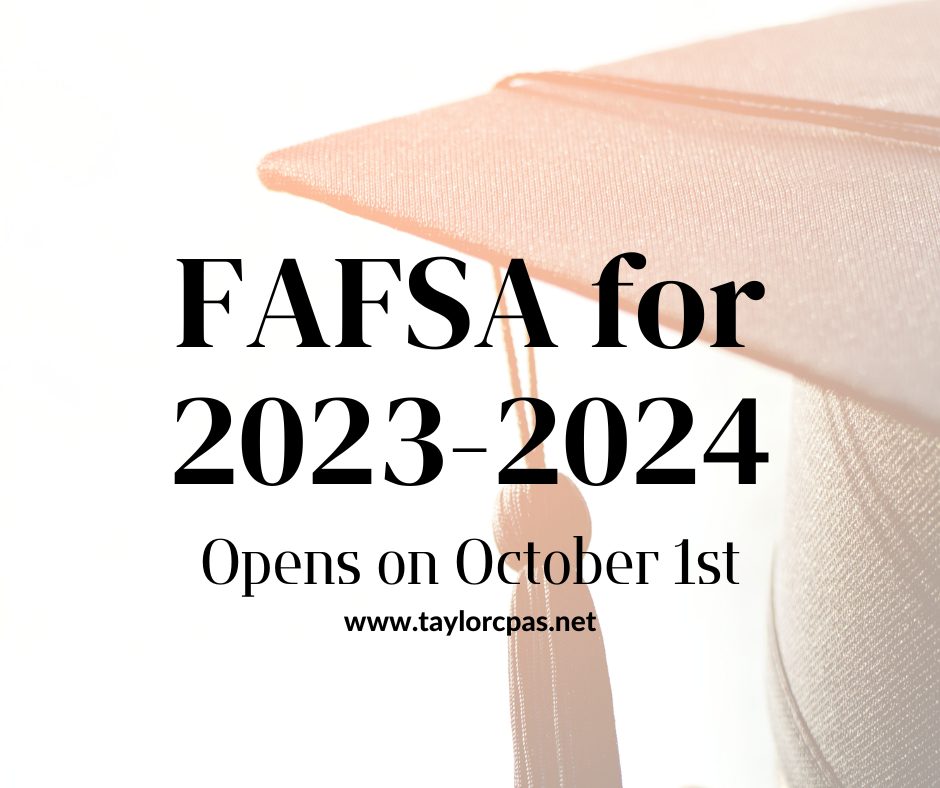2024 Annual Tax Planning & Strategy Guide We are pleased to announce the delivery of…

FAFSA for 2023-2024 School Year Opens on October 1
October is the kickoff month for financial aid. That’s when incoming and returning college students can start filing the Free Application for Federal Student Aid (FAFSA) for the next academic year. The FAFSA is a prerequisite for federal student loans, grants, and work-study, and may be required by colleges before they distribute their own institutional aid to students.
How do I submit the FAFSA?
The FAFSA for the 2023-2024 school year opens on October 1, 2022. Here are some tips for filing it.
- The fastest and easiest way to submit the FAFSA is online at studentaid.gov. The site contains resources and tools to help you complete the form, including a list of the documents and information you’ll need to file it. The online FAFSA allows your tax data to be directly imported from the IRS, which speeds up the overall process and reduces errors. The FAFSA can also be filed in paper form, but it will take much longer for the government to process it.
- Before you file the FAFSA online, you and your child will each need to obtain an FSA ID (federal student aid ID), which you can also do online by following the instructions. Once you have an FSA ID, you can use the same one each year.
- You don’t need to complete the FAFSA in October, but it’s a good idea to file it as early as possible in the fall. This is because some federal aid programs operate on a first-come, first-served basis. Colleges typically have a priority filing date for both incoming and returning students; the priority filing date can be found in the financial aid section of a college’s website. You should submit the FAFSA before that date.
- Students must submit the FAFSA every year to be eligible for financial aid (along with any other college-specific financial aid form that may be required, such as the CSS Profile). Any colleges you list on the FAFSA will also get a copy of the report.
- There is no cost to submit the FAFSA.
How does the FAFSA calculate financial need?
The FAFSA looks at a family’s income, assets, and household information to calculate a family’s financial need. This figure is known as the expected family contribution, or EFC. All financial aid packages are built around this number.
When counting income, the FAFSA uses information in your tax return from two years earlier. This year is often referred to as the “base year” or the “prior-prior year.” For example, the 2023-2024 FAFSA will use income information in your 2021 tax return, so 2021 would be the base year or prior-prior year.
When counting assets, the FAFSA uses the current value of your and your child’s assets. Some assets are not counted and do not need to be listed on the FAFSA. These include home equity in a primary residence, retirement accounts (e.g., 401k, IRA), annuities, and cash-value life insurance. Student assets are weighted more heavily than parent assets; students must contribute 20% of their assets vs. 5.6% for parents.
Your EFC remains constant, no matter which college your child attends. The difference between your EFC and a college’s cost of attendance equals your child’s financial need. Your child’s financial need will be different at every school.
After your EFC is calculated, the financial aid administrator at your child’s school will attempt to craft an aid package to meet your child’s financial need by offering a combination of loans, grants, scholarships, and work-study. Keep in mind that colleges are not obligated to meet 100% of your child’s financial need. If they don’t, you are responsible for paying the difference. Colleges often advertise on their website and brochures whether they meet “100% of demonstrated need.”
Should I file the FAFSA even if my child is unlikely to qualify for aid?
Yes, probably. There are two good reasons to submit the FAFSA even if you don’t expect your child to qualify for need-based aid.
First, all students attending college at least half time are eligible for unsubsidized federal student loans, regardless of financial need or income level. (“Unsubsidized” means the borrower, rather than the federal government, pays the interest that accrues during school, the grace period, and any deferment periods after graduation.) If you want your child to be eligible for this federal loan, you’ll need to submit the FAFSA. But don’t worry, your child won’t be locked in to taking out the loan. If you submit the FAFSA and then decide your child doesn’t need the student loan, your child can decline it through the college’s financial aid portal before the start of the school year.
Second, colleges typically require the FAFSA when distributing their own need-based aid, and in some cases as a prerequisite for merit aid. So filing the FAFSA can give your child the broadest opportunity to be eligible for college-based aid. Similarly, many private scholarship sources may want to see the results of the FAFSA.
Changes are coming to next year’s FAFSA
Changes are coming to the 2024-2025 FAFSA, which will be available October 1, 2023. These changes are being implemented a year later than originally planned. One notable modification is the term “expected family contribution,” or EFC, will be replaced by “student aid index,” or SAI, to better reflect what this number is supposed to represent — a measure of aid eligibility and not a definite amount of what families will pay. Other important changes are that parents with multiple children in college at the same time will no longer receive a discount in the form of a divided SAI; income protection allowances for both parents and students will be increased; and cash support to students and other types of income will no longer have to be reported on the FAFSA, including funds from a grandparent-owned 529 plan.
ONE ADVISOR | TWICE THE ADVICETM
FAFSA is an important step in the financial aid process and can help you save on college costs. We can show you how your eligibility could benefit you or your child’s long-term financial success. Give us a call today at (410) 823-5442 or email [email protected].
For disclaimer, please follow our link below:
https://www.peakeadvisors.com/site/wp-content/uploads/2019/05/Compliance-Social-Media-Disclaimer.pdf

